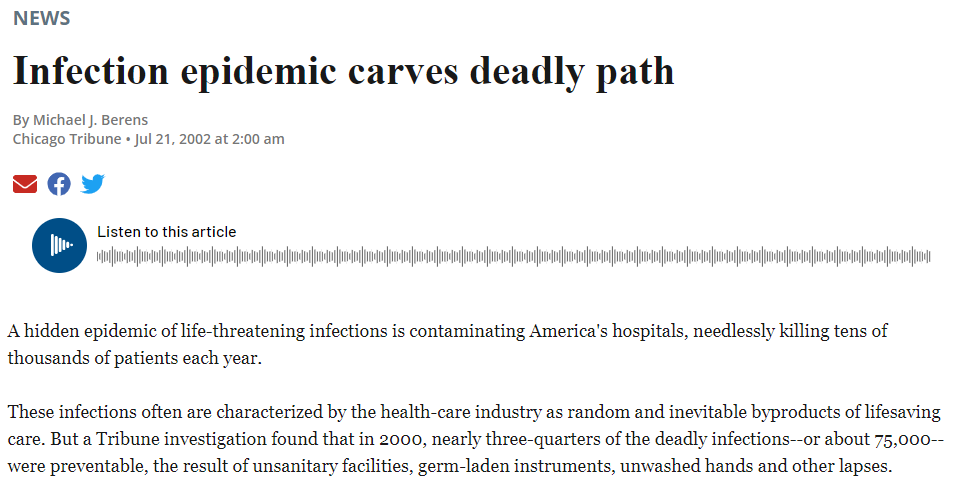[ANSWERED] Why is infection control important to healthcare workers?
In order for facilities to continue to offer quality and safe healthcare delivery, infection control must be a top priority.

1 in 10 patients gets an infection while receiving care.
But risks of infection don’t solely lie with patients, healthcare workers are also at high risk. These professionals are in regular contact with infectious sources. This is in comparison to the general public who in turn, have a much lower risk.
This is where Infection Prevention and Control (IPC) comes in. IPC is important when it comes to protecting the public from harmful infections. Healthcare workers often face exposure to infectious diseases, that’s their job. But this increases the risk of spreading an infection to other workers and patients.

Poor infection control means higher rates of disease and drug-resistant bacteria. This can also increase the risk of outbreaks within a community. Not to mention compromise healthcare facilities, making it more difficult to treat patients.
In order for facilities to continue to offer quality and safe healthcare delivery, infection control must be a top priority.
What is Infection Control?
Infection control refers to the policies and procedures that help control the spread of healthcare-associated infections (HAIs). HAIs are infections that people get while receiving care in a healthcare facility. These facilities can include hospitals, renal disease facilities, and long-term care facilities.
In fact, HAIs are one of the most common healthcare complications today. About 1 in 31 hospital patients has at least one healthcare-associated infection. These infections can be a huge threat to not only patients but healthcare facilities. They can also cause long-term hospital stays, disabilities, and unnecessary deaths.
Early infection control programs in the United States ran through academic centers. It wasn’t until the late 19th and early 20th century that we saw a shift in infection control management in public health agencies.
It was due to the following events that this change came about…
- The Institute of Medicine’s 1999 report on errors in health care.
- The 2002 Chicago Tribune representation on HAIs.
- The 2004/2006 publications of the significant reductions in bloodstream infection rate.

With higher public expectations, infection control is no longer viewed as unpreventable. The shift from infection control to prevention requires fast recognition and intervention programs.
When talking about interventions, there are specific precautions that are necessary. The following are some examples of transmission-based precautions, depending on the microorganism.
Standard precautions. These are necessary for all patient care…
- Hand hygiene.
- Personal Protective Equipment.
- Appropriate patient placement.
- Clean and disinfect patient care equipment.
- Textiles and laundry management.
- Safe injection practices.
- Proper disposal of needles and other sharp objects.

Contact precautions. These precautions are for patients with known or suspected infections that can spread through contact…
- Use standard precautions.
- Limit transport and movement of patients.
- Use disposable patient care equipment.
- Thorough cleaning and disinfection strategies.
Droplet precautions. These precautions are for patients with known or suspected infections that can spread through air droplets. This can happen by coughing, sneezing, or talking…
- Control the source by placing a mask on the patient.
- Use Standard Precautions.
- Limit transport and movement of patients.
Airborne precautions are for patients with infections that can spread through airborne routes. Use an airborne isolation room if possible and follow all precautions. This includes standard, contact, and droplet precautions.
The main purpose of an infection control program is to minimize the risk for HAIs. More specifically it helps develop, install, and test measures and interventions.
Infection Control Plan
Having a strong infection control plan means having programs in the forms of…
- Surveillance
- Isolation
- Outbreak management
- Education
- Employee health
- Environmental hygiene
These specific programs should supplement the existing prevention policies and management. Control plans are usually put into place by the hospital’s infection control committee and epidemiologists. They enforce general procedures in all departments.
Surveillance
There are three goals when it comes to infectious disease surveillance…
- Describe the current epidemiology of the disease
- Check trends
- Identify outbreaks
In recent years this has become a mandatory rule by public health authorities in many states.
The use of electronic health records in most hospitals across the country has made surveillance easier. Now medical professionals can access electronic records to quickly assess risks for each patient.
On a community level, public health agencies are now asking hospitals to report infections. Keeping an eye on certain infections through this data helps strengthen the public health surveillance system as a whole.
Isolation
Isolation prevents the transmission of microorganisms from one patient to another. When hospitals have single patient rooms, this type of program can install isolation practices.
But, when this is not available, isolation criteria can be a challenge to meet. This may be the case for long-term or residential settings
In this case, you can make room placement decisions balancing risks to the other patients. If isolation in single rooms is not possible, precautions are necessary.
Outbreak Investigation and Management
Once an infection monthly rate crosses the 95% threshold, an investigation is necessary for a possible outbreak.
Reporting these instances can then shift the action from investigative to management. Following the discovery of an outbreak, healthcare facilities must act to contain it. Depending on the cause of the infection, isolation and certain precautions may be necessary.

Education
Education and training on a regular basis are very important. Making sure to reinforce employees’ knowledge of infection control and prevention is the first line of defense in this field.
Annual online training can help keep employees up to date on procedures as they change.
Employee Health
The infection control program needs to work with employee health service to ensure a safe work environment.
Both teams must address certain topics. These topics should range from exposure management to specific infections.
All new employees should undergo a screening to ensure they are up-to-date with vaccinations.
Additionally, existing employees should continue to stay up-to-date with annual influenza vaccinations. Regularly testing for latent tuberculosis is another way hospitals offer preventative health solutions.
Environmental Hygiene
The environmental hygiene program is probably one of the most obvious sections.
With the inpatient population more susceptible to infection, making sure to keep the facility clean is crucial.
Managing a safe and clean environment can include methods such as…
- Steam Cleaning
- Antimicrobial surfaces
- Automated Dispersal Systems
- Sterilization techniques and Disinfectants
There are further guidelines the CDC has available that emphasize and go into more detail about how to manage a hygienic environment. Cleaning and disinfection of environmental surfaces are not as obvious of a task as you may think.
For example, make sure to use a proper cleaner before disinfection. This initial cleaning removes organic matter, salts, and visible soils. The physical act of scrubbing with soap and water removes a large amount of bacteria on surfaces.
Environmental hygiene plans require the collaboration of several different types of professionals including...
- Hospital engineers
- Federal agencies
- Architects
- Public health professionals
- Medical professionals
Conclusion
HAIs can have a massive impact on physical, mental, emotional, and financial health.
Many of these HAIs are due to pathogens that are outsmarting antimicrobial medications. These medications include antibiotics, antivirals, antifungals, and antiparasitics. Antimicrobial medicines can prevent and treat HAIs.
However, the overuse or misuse of them can cause more infectious and dangerous viruses. These resistant pathogens and emerging infectious diseases require strong infection control programs.
Emphasize your product's unique features or benefits to differentiate it from competitors
In nec dictum adipiscing pharetra enim etiam scelerisque dolor purus ipsum egestas cursus vulputate arcu egestas ut eu sed mollis consectetur mattis pharetra curabitur et maecenas in mattis fames consectetur ipsum quis risus mauris aliquam ornare nisl purus at ipsum nulla accumsan consectetur vestibulum suspendisse aliquam condimentum scelerisque lacinia pellentesque vestibulum condimentum turpis ligula pharetra dictum sapien facilisis sapien at sagittis et cursus congue.
- Pharetra curabitur et maecenas in mattis fames consectetur ipsum quis risus.
- Justo urna nisi auctor consequat consectetur dolor lectus blandit.
- Eget egestas volutpat lacinia vestibulum vitae mattis hendrerit.
- Ornare elit odio tellus orci bibendum dictum id sem congue enim amet diam.
Incorporate statistics or specific numbers to highlight the effectiveness or popularity of your offering
Convallis pellentesque ullamcorper sapien sed tristique fermentum proin amet quam tincidunt feugiat vitae neque quisque odio ut pellentesque ac mauris eget lectus. Pretium arcu turpis lacus sapien sit at eu sapien duis magna nunc nibh nam non ut nibh ultrices ultrices elementum egestas enim nisl sed cursus pellentesque sit dignissim enim euismod sit et convallis sed pelis viverra quam at nisl sit pharetra enim nisl nec vestibulum posuere in volutpat sed blandit neque risus.

Use time-sensitive language to encourage immediate action, such as "Limited Time Offer
Feugiat vitae neque quisque odio ut pellentesque ac mauris eget lectus. Pretium arcu turpis lacus sapien sit at eu sapien duis magna nunc nibh nam non ut nibh ultrices ultrices elementum egestas enim nisl sed cursus pellentesque sit dignissim enim euismod sit et convallis sed pelis viverra quam at nisl sit pharetra enim nisl nec vestibulum posuere in volutpat sed blandit neque risus.
- Pharetra curabitur et maecenas in mattis fames consectetur ipsum quis risus.
- Justo urna nisi auctor consequat consectetur dolor lectus blandit.
- Eget egestas volutpat lacinia vestibulum vitae mattis hendrerit.
- Ornare elit odio tellus orci bibendum dictum id sem congue enim amet diam.
Address customer pain points directly by showing how your product solves their problems
Feugiat vitae neque quisque odio ut pellentesque ac mauris eget lectus. Pretium arcu turpis lacus sapien sit at eu sapien duis magna nunc nibh nam non ut nibh ultrices ultrices elementum egestas enim nisl sed cursus pellentesque sit dignissim enim euismod sit et convallis sed pelis viverra quam at nisl sit pharetra enim nisl nec vestibulum posuere in volutpat sed blandit neque risus.
Vel etiam vel amet aenean eget in habitasse nunc duis tellus sem turpis risus aliquam ac volutpat tellus eu faucibus ullamcorper.
Tailor titles to your ideal customer segment using phrases like "Designed for Busy Professionals
Sed pretium id nibh id sit felis vitae volutpat volutpat adipiscing at sodales neque lectus mi phasellus commodo at elit suspendisse ornare faucibus lectus purus viverra in nec aliquet commodo et sed sed nisi tempor mi pellentesque arcu viverra pretium duis enim vulputate dignissim etiam ultrices vitae neque urna proin nibh diam turpis augue lacus.




